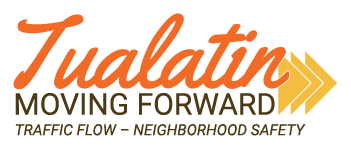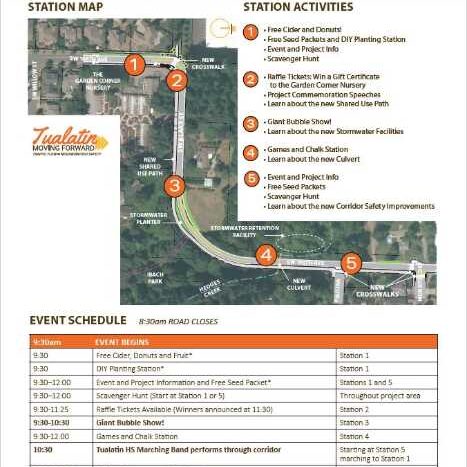In the News
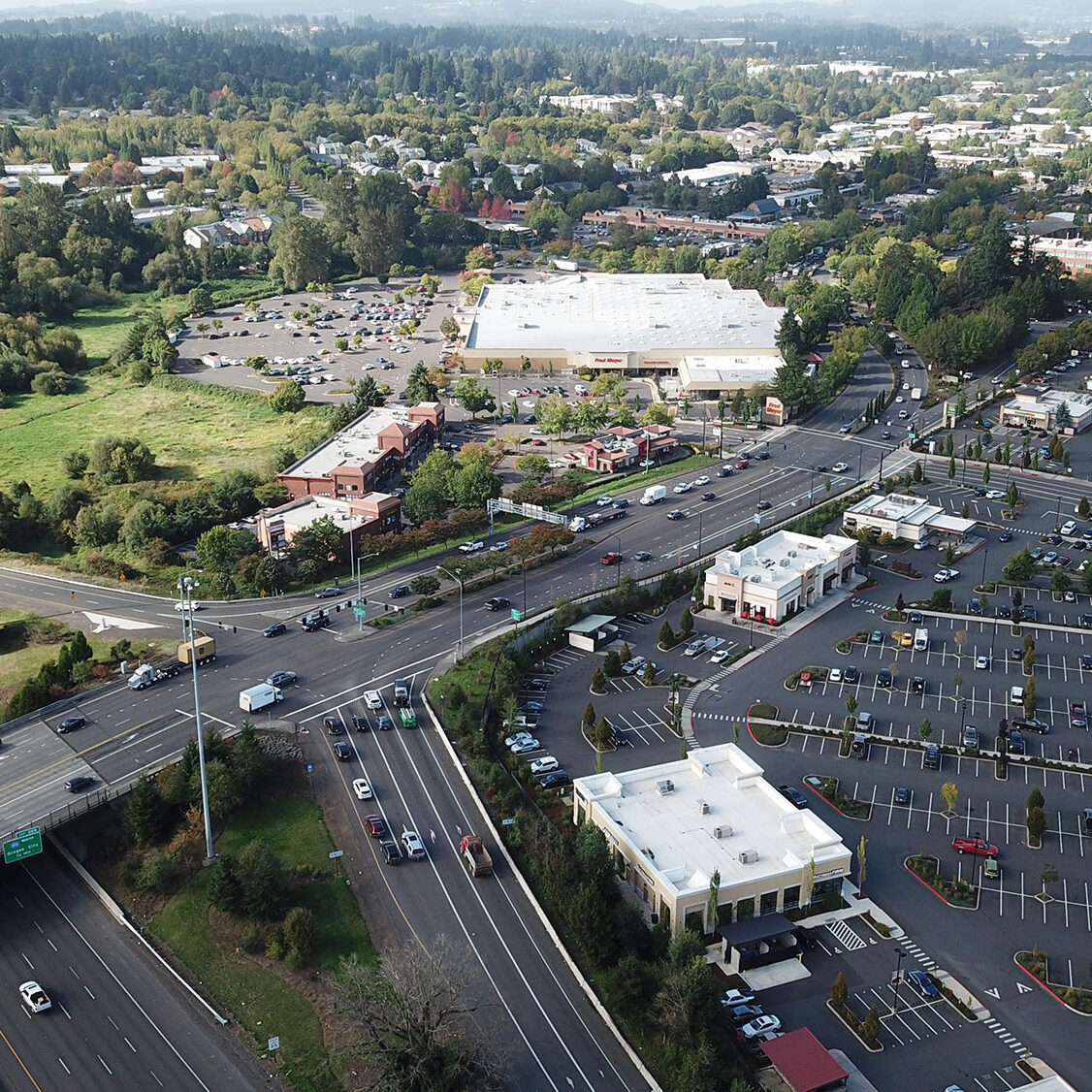
News Release from City of Tualatin | June 1, 2023
RESHAPING THE NYBERG ROAD/TUALATIN-SHERWOOD ROAD/I-5 INTERSECTION--STARTS SOON!
After four years of engineering studies and community engagement, construction is set to begin in May for transportation improvements around the Nyberg Road/Tualatin-Sherwood Road/I-5 interchange.
The project will:
- Add a third eastbound lane from Martinazzi Avenue to I-5.
- Repave and restripe lanes for more efficient traffic flow.
- Enhance directional signage.
- Improve bicycle access and safety throughout this corridor.
Eastbound drivers will see a new lane created by narrowing the median. The directional signage and lane markings will guide drivers into the correct lane and minimize last-second lane changes approaching the north- and south-bound I-5 ramps.
Mike McCarthy, PE. Tualatin City Engineer, predicts this signature transportation project will make travel here safer and more predictable: “The project will deliver a series of small, strategic changes that ensure this congested area operates more smoothly.”
The payoff will be significant time savings for drivers. Travel time from Boones Ferry Road to I-5:
- Morning rush hour ✓ Reduced from 6.5 minutes to 4 minutes
- Afternoon rush hour ✓ Reduced from 8 minutes to 6 minutes
For people who ride bikes in this area, the eastbound bike lane, which currently squeezes between two lanes of traffic, will be moved next to the curb. A new signalized crossing will help bicyclists safely cross the I-5 southbound ramp. In addition, new buffered bike lanes and signage will direct bicyclists to the existing Tualatin River Greenway path that connects underneath I-5—a much safer and more pleasant route through the area.
Most of the construction will be done at night. Work will be completed by the end of the year. “This is our City’s busiest intersection, navigated every day by almost every Tualatin resident. I can’t wait to see the results in time savings and reduced congestion,” says Tualatin City Manager Sherilyn Lombos.
The $2.7 million project is funded by Tualatin Moving Forward. In May 2018, Tualatin voters approved this $20 million bond program to fund projects that relieve congestion, improve neighborhood traffic safety and provide safe access to schools and parks. Now, 24 projects are complete and another 12 are underway.
To learn more, visit the project page.
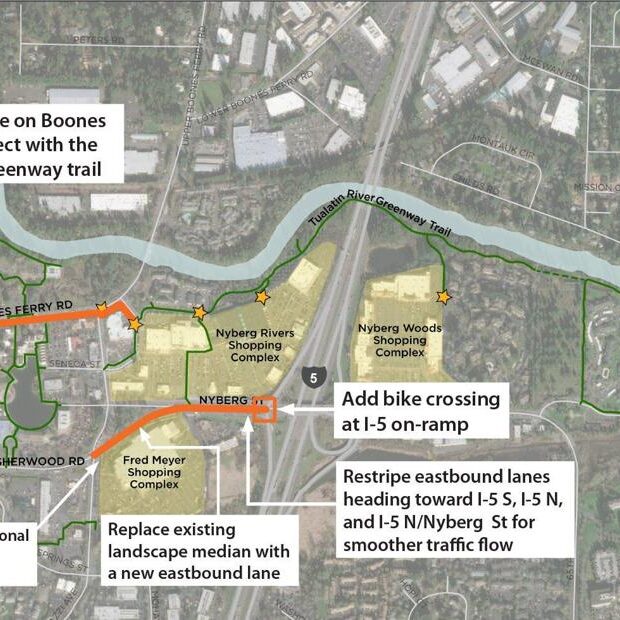
Business Tribune | January 18, 2023
Planned re-striping, lane addition could shave minutes off Tualatin-Sherwood Road to I-5 commute
Tualatin is entering the final stretch of spending bond money voters approved in 2018 for safety projects and other roadway improvements.
The most ambitious undertaking is a plan to shave minutes off the time motorists spend on eastbound Southwest Tualatin-Sherwood Road headed to Interstate 5.
To accomplish that, the $2 million plan calls for both re-striping existing eastbound lanes from Southwest Martinazzi Avenue to Interstate 5 and adding another lane.
“Our plan is to reorient — and that’s where’s there’s quite a bit of striping involved — so that the right lane will go to I-5 south, the middle lane will go to I-5 north, and the left lane can be used to either get across the freeway to Nyberg Street or on to I-5 north,” said Tualatin city engineer Mike McCarthy.
In addition, plans are underway to widen the section of eastbound Tualatin-Sherwood Road between...
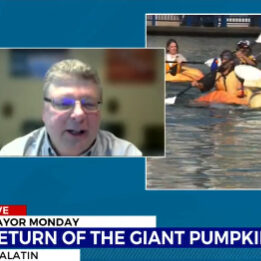
KOIN.com | March 28, 2022
Tualatin mayor discusses new traffic signal, equity committee
AM Extra is heading into the suburbs to the city of Tualatin, which has become a popular place for families to settle down.
The residential community is quickly growing, and Mayor Frank Bubenik joined AM Extra to share updates on some ongoing city projects and the return of a big event.
A new traffic light has been added at a busy intersection as part of the Tualatin Moving Forward Bond Program. Along with that, the city created an equity committee.
Meanwhile, the return of the west coast Giant Pumpkin Regatta is expected this fall.
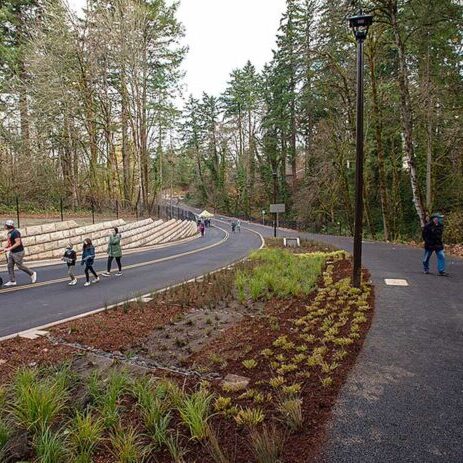
Tualatin Life | January 23, 2022
Tualatin continues Moving Forward in ‘Best Year Yet’
City officials have dubbed 2021 “the best year yet” in the life of the transportation and pedestrian safety centered Tualatin Moving Forward project.
Tualatin Senior Transportation Engineer Mike McCarthy detailed the year’s successes in an end-of-year brief to City Council last month, including the November opening celebration of the $20 million bond project’s current crown jewel, Garden Corner Curves.
Building on the momentum of a robust 2020, six projects that improved life for bikers and pedestrians and peppered the city with new public art were completed in 2021 bringing the total to 20 with another 14 in progress as the calendar flipped.
“We had another really good year, and I’ll keep knocking on wood because it’s been really wonderful. We are excited with how things are working,” McCarthy said. “We’re getting to an exciting time in the program where we’re really seeing things on the ground and really seeing things happening.”
The program’s budget is also thriving...
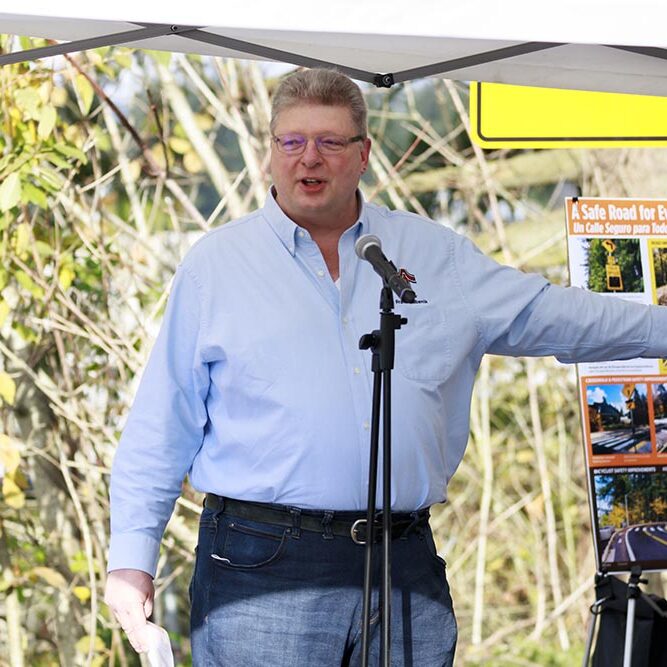
Tualatin Life | December 1, 2021
Mayor’s Corner: December 2021
Garden Corner Curves
November 20th was a beautiful day for the Garden Corner Curves reopening celebration. The Garden Corner Curves project is one of the signature projects of the $20 million Tualatin Moving Forward transportation bond, approved by voters in 2018. Three hundred people from more than 40 different companies actively worked on this project. It took five years of planning and two years of construction to create a safe corridor for four thousand drivers a day plus people out walking, cycling, jogging, and rolling along the pathway.
The goal was to fit in everything that the community desired: to build a safer space to walk or bike between neighborhoods, maximize safety, provide lighting, keep the creek from flooding over the road, keep speeds down, protect the environment, and preserve as many trees as possible – all while making it look nice. The goal was achieved.
This project came together because of the work of former city councilor Robert Kellogg and the Ibach Community Involvement Organization (CIO). To recognize Councilor Robert Kellogg’s involvement and commitment, a commemorative boulder has been placed on the roadway. Thank you, Robert, for all your efforts on behalf of the residents of Tualatin.
Holiday Lights Parade
The Holiday Lights Parade Series will be coming back this December. The dates are:
- Saturday, December 4 – North Parade (Includes neighborhoods around Community Park and Jurgens Park)
- Saturday, December 11 – South Parade (Includes neighborhoods around Ibach Park and Tualatin High School)
- Saturday, December 18 – East Parade (Includes neighborhoods around Atfalati Park and Browns Ferry Park)
If you’d like to participate, registration is limited for each parade. Residents are welcome to register for any of the three parades. All parades will begin at 5:30 pm, take approximately 2 hours to complete, and registration is free. For more information go to: www.tualatinoregon.gov/recreation/holiday-lights-parade.
Holiday Message
With the holiday season here, I would like to wish you and your loved ones a safe and healthy holiday season. I want to thank all you for your patience, strength, compassion, and ongoing efforts to help others in need during the COVID pandemic. I look forward to a new year filled with promise, opportunity, and goodwill.
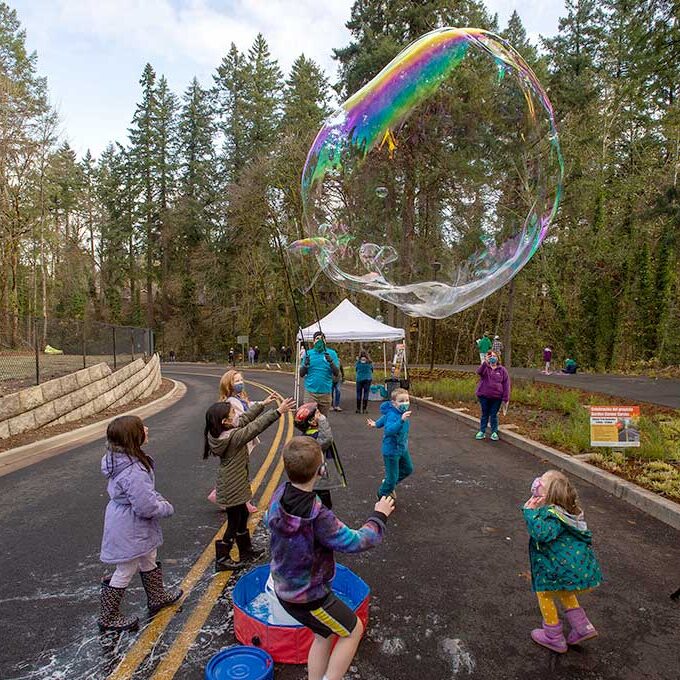
Tualatin Life | December 1, 2021
Tualatin CIO President’s Report: December 2021
CIOs Get Results
Celebration of Success
Tualatin elected officials, staff, residents, and Community Involvement Organization (CIO) leaders celebrated the official opening of the Garden Corner Curves on Saturday, November 20th.
This public safety victory for residents has many authors, but only one group can take credit for initially identifying the problem and pursuing a solution with energy, persuasion, and perseverance: the volunteers of Ibach and Midwest CIOs by convincing the city over many years to take action. The argument was clear: it was a dangerous curve.
Rejuvenation & Looking for Volunteers to Champion Current Issues
CIOs’ role of speaking up for residents and businesses is not over.
At the Garden Corner Curves celebration, Ed Casey, current Ibach CIO President, asked residents to sign up to help with current issues. Promoting livability is hard, but it can be done. Voicing concerns takes teamwork. It takes effort. That is what CIOs can do.
COVID damaged the economy, our lives and our businesses. It also made community involvement very difficult. CIO leaders faced great challenges in providing citizen and community involvement events and communication.
Then in August 2021, with improved city support and refreshed leadership, the CIO program underwent a rejuvenation progress. We launched a new website at www.tualatincio.org and held meetings via Zoom using the model Martinazzi Woods CIO created. At our website, you can read our story, find your CIO, read about accomplishments and current issues, and, of course, share an issue you think needs follow-up.
What CIOs Do
CIO leaders and volunteers worked to advance community issues to City staff, City Council, Metro and State agencies; in some cases, created change. Other projects facilitated communication of City information to the neighborhoods.
During the past ten years, we’ve served as community safety advocates, watchdogs of regulation changes, and enforcement, Tualatin livability and equity advocates, and agents of strong neighborhood bonds. Below lists some of our successes. For the full report, go to our website.
We Are Community Safety Advocates
Championed for many years the much-needed Garden Corners Curves construction/sidewalk project.
Confirmed pedestrian safety as a priority in TSP, assisted in locating marked crosswalks, speed control signs in school zones, $20 million bond to fund some of these projects.
Requested creation of emergency preparedness support resulting in the creation of CERT, Ham Radio Emergency Net, and Tualatin Neighborhood Ready (TNR) education outreach both in person and via Zoom. CERT currently has 109 active CERTs and 87 licensed Ham operators.
We Are Watchdogs of Regulation Changes and Enforcement
Created the Clean Air Safe Environment Committee (CASE), partnering with Metro and DEQ to monitor Grimm’s composting. The process significantly reduced odors and improved relationships between neighbors and the company.
Participated in planning meetings and requested that the elevated bridge on SW Blake Street at Garden Corner’s curve be removed from the Transportation System Plan (TSP).
Held meetings providing community feedback challenging a proposed mini-mart/gas station within the boundary of residential homes.
We Promote Tualatin Livability and Equity Advocates
Supported Ride Connection expansion outside Tualatin’s east boundary.
Used CIO grant funds to install two park benches in the Pony Ridge Greenway.
Used grant funds to support the new track at Bridgeport Elementary School.
Promoted allowing backyard chickens into municipal code.
We are Agents of Strong Neighborhood Bonds
Prior to March 2020 and the pandemic, held annual meetings with members inviting Tualatin Police, TVFR, and City representatives to make presentations on current topics. Since the pandemic, 3 CIOs have held member meetings via Zoom.
Over a period of a year, invited neighbors to promote, gained City approval, and assisted with the design of a new off-leash dog area in Jurgen’s Park.
All residential CIOs mapped out their areas and joined Nextdoor to help bring neighbors and organizations together by CIO area.
Invited Tualatin Neighborhood Ready (TNR) to their neighborhoods, homes, and businesses to create a local emergency plan. More than 750 residents and businesses have participated in TNR education programs.
Do you care about Tualatin? Are you interested in what is going on? Are you concerned about all of the changes happening to Tualatin? Is it time for you to get involved? If so, contact us at tualatincio@gmail.com.
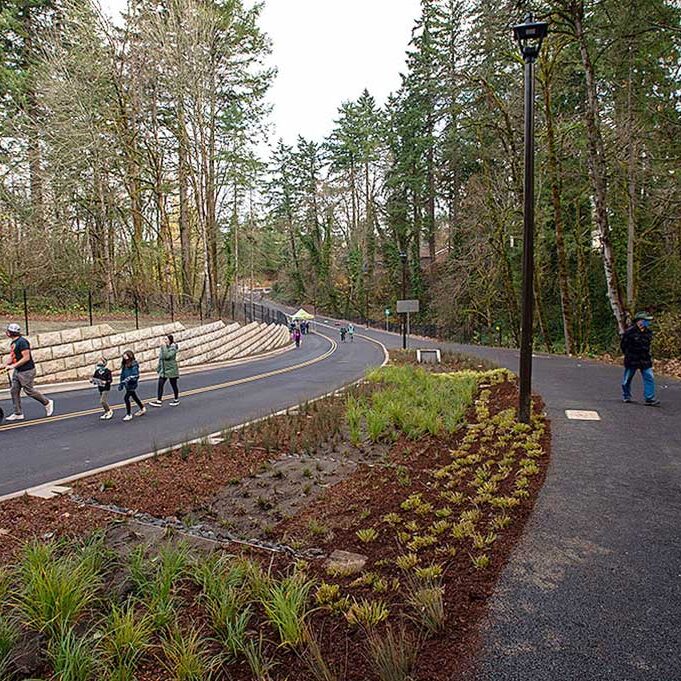
Tualatin Life | December 1, 2021
Hundreds turn out for Garden Corner Curves celebration
$3 million road improvement project is a highlight of Tualatin Moving Forward program
Hundreds of Tualatin residents turned out on Saturday, Nov. 20, to celebrate the long-awaited completion of the Garden Corner Curves road improvement project in the Ibach neighborhood.
The $3 million project brought a new and improved roadway to the sharp S-curve that sees S.W. 105th Avenue transition to S.W. 108th Avenue just north of Ibach Street. In addition, the project added a paved pedestrian and bike path to the curves, along with a new culvert and fish passage over Hedges Creek, which passes under 105th just north of where the curves begin.
This corridor is heavily used by local residents, with around 4,000 vehicle trips per day being the norm. Now, cyclists and pedestrians will be able to safely share the route with vehicles and will take advantage of a pair of rapid flashing beacons that mark protected crosswalks on either end of the curves.
“It’s amazing that we all saw the pictures many years ago, and it looks just like the pictures,” Mayor Frank Bubenik said. “None of us could envision it. They would go ‘There’s no way we can do this,’ and they did it. So, it’s very impressive what’s been done here and we’re super proud of it.”
The Garden Corner Curves is the single largest piece of the wider $20 million Tualatin Moving Forward bond measure approved by voters in 2018. To date, the bond has funded 15 completed projects, with a number of others still to come. But the Curves is almost certainly the most highly anticipated piece of the bond puzzle.
“We heard for years from the people in this neighborhood that they wanted these curves fixed,” Bubenik said. “Work on this project started well before 2018. It took five years of planning and two years of construction to get to where we are today.”
Bubenik also praised the work of former City Councilor Robert Kellogg, who was instrumental in seeing the project through to completion with his advocacy.
“He never gave up, before he was on council, while he was on council, even after he was on council, he tirelessly advocated for this project,” Bubenik said.
One of the biggest beneficiaries of the project, as well as its namesake, is the Garden Corner Nursery, located at the south end of the curves.
“Before the opening, it was kind of scary, folks would try to get past all the traffic,” said Garden Corner owner Jonn Karsseboom. “Now, this is a relaxing beautiful walk, it goes all the way down.
TheTimes | November 19, 2021
City celebrates reopening of Garden Corner Curves
A Saturday celebration at the curves will include a marching band, a scavenger hunt, cider, donuts and more.
Residents are invited to celebrate the reopening of Tualatin's Garden Corner Curves on Saturday, Nov. 20, from 9:30 a.m. to noon.
The gathering will be held at the curves, which follow Southwest 105th Avenue/Blake Street/108th Avenue between Avery and Willow street. Residents are invited to walk or roll through the corridor. The road will be closed from The Garden Corner Nursery to about Mortatoc Drive with a variety of activity stations open to the public. (See accompanying map)
In addition to raffle prizes, attendees can enjoy free cider and donuts.
Also, there will be a visit by the Tualatin High School marching band (weather permitting), a scavenger hunt, a giant bubble show, games, and a do-it-yourself planting project.
The event will comply with all COVID-19 protocols.
The Garden Corner Curves corridor officially shut down on June 28 when the city closed traffic from Southwest Industrial Way to Ibach Street to make improvements to the narrow, constrained roadway.
Those included removing (and recycling) most of the existing asphalt — including some of the road area down by Hedges Creek, before a 15-foot-wide and 5-foot-high concrete box culvert was installed to help the creek flow through.
The new roadway now contains 10-foot-wide vehicle lanes, similar to the entire width of the old roadway.
Funding for the project came from come from a $20 million bond passed by Tualatin voters in 2018 and administered through Tualatin Moving Forward, a local transportation improvement program.
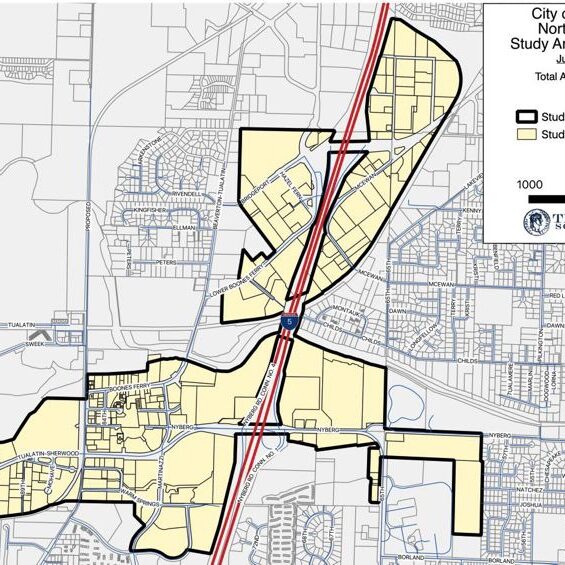
PortlandTribune | July 12, 2021
Tualatin weighs 'urban renewal' in commercial core
A decision may be years off, as city officials want to gather input and determine the area's needs.
They're not what most people would likely consider "blighted areas."
Bridgeport Village, which is shared with Tigard and tiny neighboring Durham, opened in 2005. Nyberg Woods followed in 2007. Nyberg Rivers, home of Cabela's, Cracker Barrel Old Country Store, New Seasons Market and more, was just developed and built out last decade.
But while officials have yet to make a final decision — and they aren't expected to for a while yet — Tualatin is eyeing a process in state law that is typically used to revitalize aging downtowns, sagging industrial districts and other struggling neighborhoods as a way to improve its core commercial areas.
What is blight?
Oregon law states that a local government can designate a blighted area as an "urban renewal area," allowing it to effectively bottle up tax revenues above a certain level and use those proceeds to pay for improvement projects. The idea is straightforward: Without raising taxes on property owners in a woebegone part of town that needs some TLC, their tax dollars can be spent over a period of years or decades toward fixing up the area and ultimately improving property values.
But "blight" is in the eye of the beholder.
"Layman's terms, you would think dilapidated, abandoned, unsafe," acknowledged Jonathan Taylor, Tualatin's economic development manager.
But he pointed out that the legal definition of what constitutes a blighted area is a lot more expansive than that. An area can be considered blighted because it doesn't have enough road capacity, for instance, or because there is a growing "lack of proper utilization" of land, however officials want to define that.
Even the provision of law that specifically mentions "dilapidation" also mentions "obsolescence" or "shifting of uses" as a reason that an area can be described as blighted. That's a consideration for Tualatin's city government in these parts of town, as retail shopping has given way to online ordering.
As an economic development official, Taylor is especially concerned about traffic. Tualatin has been plagued by bad traffic for years — a consequence of both hosting regional shopping destinations like Cabela's and being at the junction of major travel routes, including Interstates 5 and 205, Southwest Tualatin-Sherwood Road, Southwest Boones Ferry Road, and Southwest 65th Avenue (which forms part of the boundary between Washington and Clackamas counties).
"Our businesses survive on our transportation nodes," Taylor observed. He said city officials want to know, as properties are developed or redeveloped — with more apartment housing, for instance — how much additional strain that will place on roads and highways that are already congested for hours on a typical weekday.
A broader ecosystem
Taylor himself is a rarity in Tualatin: He both lives and works in the city of about 27,500. More than nine in 10 people in Tualatin's workforce commute from out of town.
"Our long-term vision is to maximize efficiency," Taylor said. "I personally want people to get to work and to home, to their family, as quickly as possible, because that goes to our council's goals of connected community as well as (being) environmentally conscious."
Personally, Taylor said, he'd like to see Tualatin's tangled web of streets get straightened out somehow.
Part of the perennial traffic problem just west of the Nyberg Rivers shopping center stems from the awkward, inefficient way that Southwest Tualatin-Sherwood Road, Nyberg Street and Martinazzi Avenue come together, forming a bent triangle. The string of signalized intersections on Boones Ferry Road just west of there is also prone to traffic backups.
But for Tualatin, fixing those design flaws isn't easy, as Taylor pointed out. Tualatin-Sherwood Road is a Washington County road. Boones Ferry Road is actually a state route, Highway 141, although the Oregon Department of Transportation hasn't put up signage. Privately owned railroad tracks — which are also used by TriMet for its underutilized WES commuter rail service — run right by the intersection of Tualatin-Sherwood and Boones Ferry roads.
Taylor said that as a city government, Tualatin has worked hard over the years to build and maintain good working relationships with other jurisdictions — Washington and Clackamas counties, each of which contains a portion of the city; neighbors like Tigard, Sherwood and Wilsonville, which have conducted joint planning projects with Tualatin over the years; and the state of Oregon, which largely oversees the freeways and state highway that run through downtown.
"We've always taken a very collaborative approach," Taylor said, adding that when Tualatin holds public meetings about topics that affect a county, another city, or the state or federal governments, "We always bring in our affected overlapping jurisdictions to these meetings, so the citizens can see, and the other entities can hear from not only us, but our citizens as well."
Complexities like who has say over what rights-of-way or property access are bound to drag out any major planning or "visioning" effort in Tualatin.
What to do?
Officials haven't settled on urban renewal as the best way to fix traffic problems and make other improvements in Tualatin's commercial areas, Taylor said.
Urban renewal is currently driving the revitalization of downtown Tigard and Beaverton, among other places. Tualatin itself used urban renewal decades ago to redevelop what used to be a pet food factory into the Tualatin Commons, which now hosts popular events like the West Coast Giant Pumpkin Regatta and Starry Nights & Holiday Lights.
It's a powerful and popular tool for economic development because it doesn't levy new taxes. Instead, for a set period of time, it caps the amount of tax revenue that the city and other taxing districts — Tualatin Valley Fire & Rescue and Portland Community College, for instance — collect from properties within a blighted area, and any tax collections above that "frozen base" are earmarked for a list of specific projects to improve the blighted area.
But urban renewal is not the only option. Taylor noted that Tualatin has also used "opportunity zones," which encourage investment with tax breaks and similar incentives, along the I-5 corridor and elsewhere. There are more conventional approaches, too, like the $20 million Tualatin Moving Forward bond measure that voters approved for transportation improvements in May 2018.
The Tualatin City Council isn't expected to vote on forming an urban renewal area in its core commercial areas for some time to come, if it does at all. Right now, it is focused on setting up an urban renewal area that will encompass some of its western industrial areas, as well as parts of the mostly rural Basalt Creek area that Tualatin anticipates annexing into city limits in the near future. A vote on that urban renewal plan is expected next month.
"We are finishing up with the urban renewal district in the Basalt Creek area, to do infrastructure there, because obviously, it needs it," Taylor said.
While the City Council held a work session late last month to discuss proceeding toward urban renewal in the commercial core, Taylor said there's still a lot of legwork that needs to be done before the council takes action. While he has mapped out a "study area" that would include Bridgeport Village, Nyberg Woods, Nyberg Rivers, the Fred Meyer shopping center, the Tualatin Commons and some adjoining properties, he said he knows, and councilors know, that boundary is likely to change as city officials get a better sense of Tualatin's needs and how they expect the city to change and grow in decades to come.
Taylor points to some of the community feedback the city received during its "Tualatin 2040" visioning effort as another reason to include relatively new developments in the study area.
"We want a town center. We want a downtown," Taylor said, summarizing the feedback.
Referring to the Tualatin Commons, he added, "Even though there is a downtown, there are no connecting streets through that area. … We understand that that's inadequate planning if we want that area to develop even further."
Over the next year-plus, Taylor expects the City Council will conduct more public outreach, talk to property owners, and try to figure out what can or should change in the core commercial areas.
"Urban renewal, I would say tentatively … is several years off," Taylor said.
He added, "We're not rushing this. That has been a directive. It's slow and methodical, 'get it right,' 'we'll take our time.' And part of that is to ensure that our residents … don't miss the opportunity to hear about it."
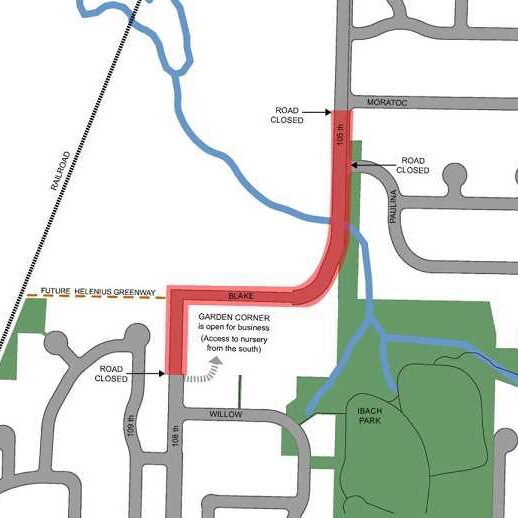
TheTimes | June 29, 2021
Garden Corner Curves improvements begin
The roadway, which includes 105th Avenue, Blake Street and 108th Avenue, officially shut down Monday.
After years of planning, major construction and roadwork on Tualatin's $4 million Garden Corner Curves project kicked off Monday, June 28.
That's when the corridor — which includes Southwest 105th Avenue, Southwest Blake Street and Southwest 108th Avenue — officially shut down. It will likely reopen in October.
"We'll be closing the road from Industrial Way to Ibach Street," said Mike McCarthy, the city's principal transportation engineer. "Local traffic will be able to get through it from Industrial Way down to Polina Street and then also from Ibach up to the (Garden Corner Nursery)."
Detour streets include Avery Street, Boones Ferry Road and Ibach Street. Garden Corner Nursery will stay open throughout the entire construction project accessed via 108th Avenue from Ibach Street, said McCarthy.
The narrow roadway, which has sight-distance safety issues and limited room for bicyclists and pedestrians, sees more than 3,000 cars pass along it daily.
After they close the road, McCarthy said workesr will remove most of the existing asphalt — including some of the road area down by Hedges Creek. In mid-July, a 15-foot-wide and 5-foot-high concrete box culvert will be installed, to help the creek flow through.
"It's quite a bit bigger than the existing culvert to prevent the creek from flowing over the road," McCarthy said.
Plans are to reuse as much asphalt from the roadway as possible.
The new road will contain 10-foot-wide vehicle lanes, similar to the current width of the roadway.
"It's intentionally fairly narrow to try to keep vehicle speeds down," said McCarthy.
Also included will be a 12-foot-wide multi-use path designed for pedestrians and cyclists on the east side of the roadway.
A new sewer line is planned for installation on top of the culvert and will run along the length of the road. Also, McCarthy said PGE will be placing new under groundpower lines along the road and also on top of the culvert, which will replace overhead lines. New communication lines will be added as well.
A new stormwater treatment pond will be built next to Hedges Creek to collect stormwater, which will use pond plants to clean it before being released back into Hedges Creek and then draining into the Tualatin River. Some retaining walls along the road also are planned as are driver speed feedback signs.
"I think for the fall, we're looking for this to be a wonderful project for the community," McCarthy said, about one of the bigger project included in the bond.
Funding for the project comes from come from a $20 million bond passed by Tualatin voters in 2018 and administered through Tualatin Moving Forward, a local transportation improvement program.
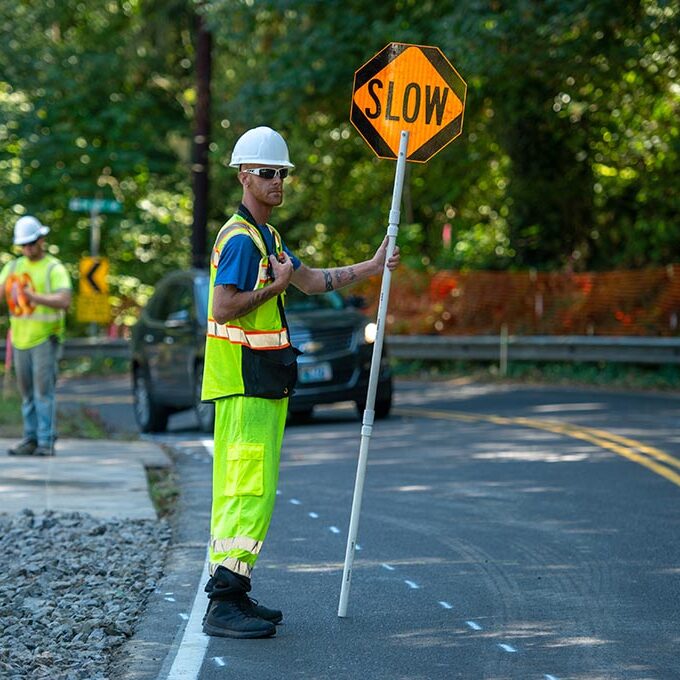
TualatinLife.com | April 1, 2021
Tualatin Council Outlines 2021 Policy Priorities

The $20 million Tualatin Moving Forward transportation bond will continue improving roads across the city in 2021, including the Garden Corner Curves shown here, and is one of the City Council’s main priorities for this year. (COURTESY/BARNEY AND WORTH)
The Tualatin City Council’s priorities for 2021 not surprisingly read like they are dealing with all of the issues that faced the city, state and country over the past year.
The City Council, with two new members, held a virtual retreat at the end of January and came away with a renewed list of issues and topics that will continue to form the city’s 2030 vision, as well as its 2021 policy priorities. Among them are housing, social justice, diversity, equity and inclusion, economic development and crisis preparedness – all areas that were at the forefront of the minds of Americans during the last year during the COVID-19 pandemic, protests over police brutality, massive wildfires and other crises.
“We spent a little over eight hours together and we covered a lot of good things,” Tualatin City Manager Sherilyn Lombos said at the Council’s March 8 meeting.
In addition to those priorities, councilors also identified transportation, the environment and community assets such as parks as a focus for the rest of 2021.
“I thought it was hugely beneficial for the City Council and City staff to come together and share conversation,” said Christen Sacco, one of two new council members. “I’m so glad we share in this forum.”
Many of these topics were featured prominently in 2020, and work in those areas will represent a continuation of what is already happening, Lombos said. This includes transportation, where the popular Tualatin Moving Forward bond measure is scheduled to continue throughout the city. The City is also considering whether or not to support the tolling of Interstate 205, as well as a proposed shuttle service along Borland Road.
In addition, the Council will soon be considering a list of police policy recommendations. This grew out of a series of Community Conversation meetings held late last year on the use of force in the wake of the protests last summer that followed the police killing of George Floyd.
Meanwhile, the COVID-19 pandemic continues to cast a long shadow over the economy in Tualatin and other Oregon cities. Unemployment figures remain high and businesses continue to struggle, even after the City distributed several million dollars last year in state and federal COVID relief money. Meanwhile, the latest relief package was passed by Congress on March 10, and another $350 billion is earmarked for state and local governments across the country.
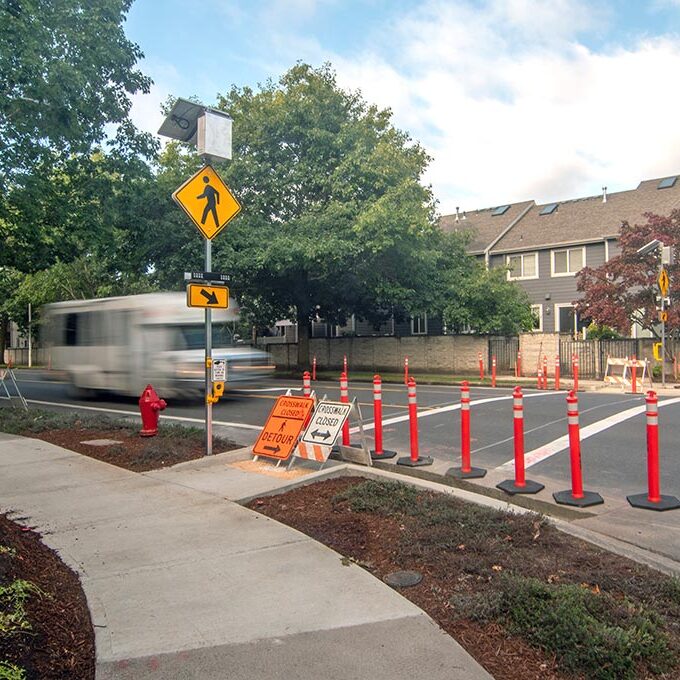
TualatinLife.com | March 1, 2021
Tualatin Moving Forward Continues Rapid Pace
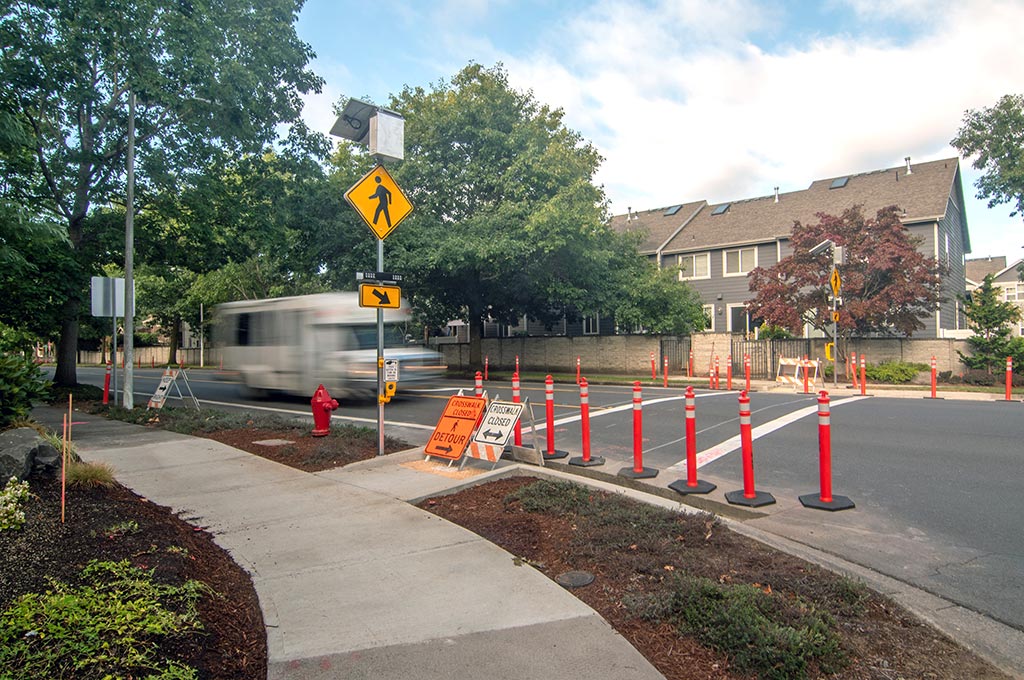
Tualatin Moving Forward is a $20 million transportation and pedestrian safety program being conducted by the City of Tualatin. Ten separate projects were completed in 2020, including this pedestrian crossing at SW 90th and Sweek Drive. (COURTESY/BARNEY AND WORTH)
2020 was a year of construction in Tualatin when it comes to transportation and pedestrian safety.
City of Tualatin Public Works Director Jeff Fuchs briefed the city council on Dec. 14 about the year’s accomplishments, which included no fewer than 10 separate projects completed and eight more starting the construction process. All of them were built as a part of the $20 million Tualatin Moving Forward bond measure, which was approved by voters in 2018. Since then, it has resulted in 14 completed projects, but 2020 was really when the program gained momentum.
Of the 10 projects completed in 2020, the most prominent is probably the improvements made on Southwest Boones Ferry Road at Tualatin High School. There, a mid-block crossing with a pedestrian refuge now allows students and pedestrians to safely cross a busy stretch of road, while sidewalk improvements line both sides of the road. New pavement along that stretch of the road was also laid during construction, even though it was paid for under the City’s pavement maintenance program.
“That’s going to be really awesome when the high school is back in session,” Fuchs said. “With this location, with the higher speed traffic, it makes a lot of sense.”
Deputy City Manager Megan George said the City would be trying different forms of public outreach in the coming year when it comes to informing residents about ongoing and future projects. The City’s Community Involvement Organizations will play a bigger role, as will online and other virtual forms of communication.
“A lot of the techniques we’ve leaned on in the early stages of the program, like kitchen table meetings and door hangers, aren’t things we want to do right now given how the world has changed,” George said. “We’ve spent a lot of time curating this list and figuring out which items are the most impactful depending on the project.”
This effort is already in motion with the Garden Corner Curves project at Southwest 108th Avenue, the single largest project of the entire initiative in terms of scope of work and cost. There, crews began construction in August and prepared a road shut down during parts of January and February after PGE finishes installing underground power lines. For road closures, the City is trying to keep residents in the loop as much as possible.
It’s a wintertime dry run for our summertime closure next July through October,” Fuchs said.
The work is paying off, as councilors praised the ongoing public engagement efforts.
“I think this has always been the gold standard for community projects,” said Councilor Nancy Grimes. “I think it’s one of the best things we’ve done as a council in a number of years, from the thoughtfulness to the way the community can be involved continuously.”
Mayor Frank Bubenik also noted that Tualatin Moving Forward has been well received by officials in other communities.
“What I particularly get from feedback from mayors in other cities is they are pretty envious with how it’s going,” Bubenik said. “They look at it as a model to emulate in how well it has been run and the community feedback involved.”
For a complete look at the 2020 Tualatin Moving Forward Annual Report visit: www.tualatinmovingforward.com/wp-content/uploads/2021/01/TMF-Annual-Report-2020.pdf.
